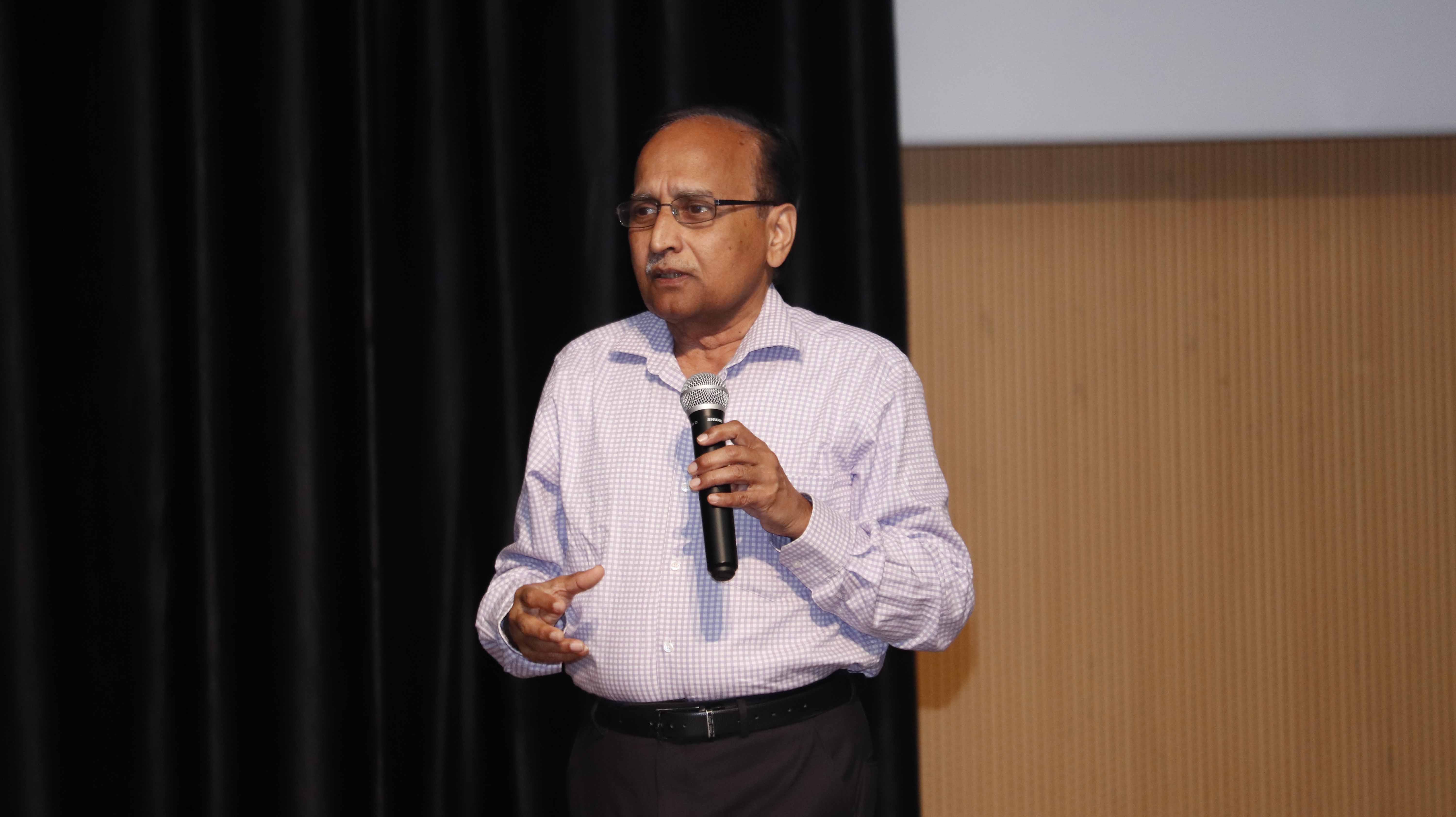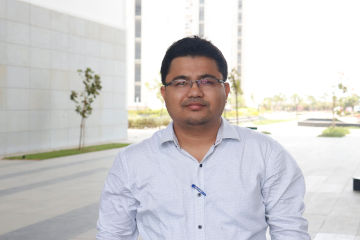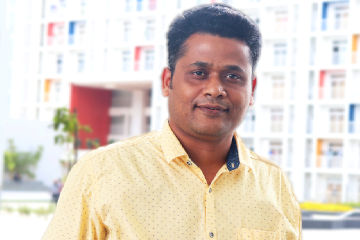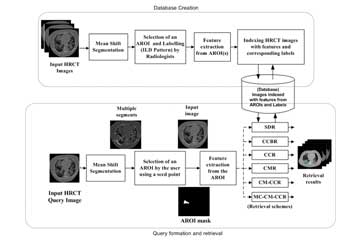Prof C Durga Rao receives a grant to enhance vaccine efficacy at a reduced cost
 Prof C Durga Rao (Principal Investigator), Professor, Department of Biological Sciences, and Associate Dean, Sciences, Department of Biological Sciences, SRM University-AP, Andhra Pradesh has received a total outlay of Rs. 1,10,52,941/- from the Department of Biotechnology, Government of India, to work on the project titled “Understanding the molecular basis for the extreme differential level of expression of genes from human and animal rotaviruses in gene-transfected cells: Implications for improving the growth of human vaccine strains”. Using the grant, the professor will be spawning the appropriate facilities to perform cell culture and virus-related research at SRM University-AP.
Prof C Durga Rao (Principal Investigator), Professor, Department of Biological Sciences, and Associate Dean, Sciences, Department of Biological Sciences, SRM University-AP, Andhra Pradesh has received a total outlay of Rs. 1,10,52,941/- from the Department of Biotechnology, Government of India, to work on the project titled “Understanding the molecular basis for the extreme differential level of expression of genes from human and animal rotaviruses in gene-transfected cells: Implications for improving the growth of human vaccine strains”. Using the grant, the professor will be spawning the appropriate facilities to perform cell culture and virus-related research at SRM University-AP.
Understanding how a virus overpowers the host resistance mechanisms and seizes the host cellular processes for its own growth is very challenging and is essential for the development of not only efficient viral vaccines but also for antiviral therapeutic strategies. Prof Durga Rao informs, “Rotavirus is the leading cause of severe and acute dehydrating diarrhoea in infants and children below 5 years of age. Efforts by us and Dr Bhan, former Secretary, Department of Biotechnology, Government of India, led to the discovery and development of the first made in India rotavirus vaccine, produced by Bharat Biotech, Hyderabad.”
In the earlier project, the professor Rao observed that while some human rotaviral proteins could be expressed at high levels when the cloned genes were introduced into mammalian cells, other proteins could not be expressed at detectable levels. However, the virus expresses copious amounts of all its proteins when it infects the cells. Prof Durga Rao further shares, “Within a few hours of infection, each virus employs several ploys in the infected cell to subvert the cellular defence and regulatory mechanisms and captures the host for its own progeny production.”
Based on the earlier observations, this project will advance to unravel the tricks employed by the virus, and viral transactions in the infected cells. The outcome of the project will have implications for genetically engineering the poorly growing human vaccine strains for their efficient growth in cell culture, leading to reduced cost of not only rotavirus vaccines, but also other viral vaccines.
- Published in News, Research News
Undergrad CSE student bags envious placement offer with a CTC of 20 Lakh LPA
 Another proud moment for SRM University-AP when Kattamuri Sai Krishna Rohith bagged an envious job offer from ODCEM Technologies Pvt. Ltd. (OneDirect) with a CTC of 20 Lakhs per annum. He is pursuing his B. Tech final year in the Department of Computer Science and Engineering.
Another proud moment for SRM University-AP when Kattamuri Sai Krishna Rohith bagged an envious job offer from ODCEM Technologies Pvt. Ltd. (OneDirect) with a CTC of 20 Lakhs per annum. He is pursuing his B. Tech final year in the Department of Computer Science and Engineering.
Mr Rohith will be joining the company as an intern for six months with monthly compensation of Rs. 20,000. After six months of internship, he will be offered the permanent employee as a Full Stack Developer with a CTC of Rs. 20,00,000 per annum.
Mr Rohith went through rigorous placement training programmes conducted by the Department of Corporate Relations and Career Services to secure the job offer. The job hiring process for this role was conducted in four stages. After preliminary selection, Mr Rohith had to prove his ability in coding, aptitude and other technical domains. The Director of Engineering himself took the final call before offering him a position in the company to see if Rohith is a proper fit for their company.
Rohith expressed his gratitude towards the CR & CS department of SRM University-AP, saying that the training sessions strengthened his core skills and abilities. He was also taught to face interviews and critical questions. Mr Rohith said, “Placement is an arduous process. I was offered another position in other company before, but I was not happy with that offer. I had faith in my abilities, so I continued searching for better opportunities and improve my skill set to secure the Super Dream offer. Keeping nerves in control, not panicking during interviews, excellent communication skills are some essential qualities that everyone should master to get good jobs. I am thankful to the CR & CS department for all their support and customised, personal, need-based assistance, which helped me a lot to prepare for the interviews,” said Mr Rohith.
After five months of determination, Mr Rohith finally secured the job that he was looking for. “The University has provided us with numerous opportunities with a flexible curriculum and Global standards. In addition to all the training, my mentors encouraged me to participate in Hackathons, apply for research internships, and attend conferences. Thanks to the extraordinary faculty that we have, the regular classes were of great help in enhancing my technical knowledge,” asserted Mr Rohith. Mr Rohith was a proud track-winner of Microsoft and EthDenver hackathons and a research Intern at Nanyang Technological University (NTU) Singapore.
He has shared his mantra to success with his fellows. Mr Rohith believes that instead of panicking or comparing with others, one should focus on becoming a better version of oneself, and the success will find him.
- Published in CR&CS, CR&CS NEWS, CSE NEWS, News
Faculty members of SRM University-AP awarded separate research grants by the National Supercomputing Mission (NSM), Government of India
 Prof Ranjit Thapa, Professor, Department of Physics, SRM University – AP, Andhra Pradesh has been awarded a first-year grant of Rs 28 Lakhs by the National Supercomputing Mission (NSM), supported by the Department of Science and Technology (DST) in collaboration with the Ministry of Electronics and Information Technology (MeITy), Government of India. Prof Ranjit will be working on the project titled “Catalysts for CO2 Reduction to C2 Product: Descriptor to Database” as the project leader. He has started the work to search for the best catalyst to convert CO2 into useful product and hence solving the problem of climate change due to large production of CO2 through different sources.
Prof Ranjit Thapa, Professor, Department of Physics, SRM University – AP, Andhra Pradesh has been awarded a first-year grant of Rs 28 Lakhs by the National Supercomputing Mission (NSM), supported by the Department of Science and Technology (DST) in collaboration with the Ministry of Electronics and Information Technology (MeITy), Government of India. Prof Ranjit will be working on the project titled “Catalysts for CO2 Reduction to C2 Product: Descriptor to Database” as the project leader. He has started the work to search for the best catalyst to convert CO2 into useful product and hence solving the problem of climate change due to large production of CO2 through different sources.
CO2 is a known greenhouse gas and key reason for global warming and climate change. Can we challenge mother nature by converting CO2, a greenhouse gas into energy with the required efficiency? This is a mystery and a mammoth problem and a much-needed problem to be solved with a fundamental approach. Prof Ranjit Thapa believes that metal nanocatalyst on support materials can solve the problem and can increase the efficiency of CO2 reduction to C2 products, viz., ethylene (C2H4) and ethanol (C2H5OH). An experimental approach to find the best catalyst for CO2 reduction needs enormous funds and trials, and a long time is required to develop the exact catalyst for industry application. The mammoth task is to find the suitable composition, shape, and size of metal nanoparticle (MNP) on an appropriate surface for the catalytic reactions. Prof. Ranjit proposes that this can be achieved by computational modelling using Density Functional Theory (DFT) through finding and estimating the electronic descriptor and revealing active sites through structure-activity relations. Recent progress in Machine Learning (ML) for materials with DFT modelling drives towards rational design of catalysts. The electronic descriptor, storage of MNP/support information in the database followed by prediction using Machine Learning (using predictive model equation) will help to narrow down the search for the best catalyst for CO2 reduction to C2 species.
 Further, Dr Mahesh Kumar Ravva, Assistant Professor, Department of Chemistry, SRM University – AP, Andhra Pradesh received Rs 19.92 Lakhs as the first instalment from DST-National Supercomputing Mission (NSM). His project’s primary focus will be on understanding the critical factors that influence the performance of organic solar cells. Using the supercomputer, his research group will model the electronic process that occurs during solar cell operation. The outcome of this project will guide experimentalists to develop organic solar cells with higher efficiency. Organic solar cells are flexible, lightweight, and low-cost and have many exciting applications in wearable electronic devices, smart windows, etc.
Further, Dr Mahesh Kumar Ravva, Assistant Professor, Department of Chemistry, SRM University – AP, Andhra Pradesh received Rs 19.92 Lakhs as the first instalment from DST-National Supercomputing Mission (NSM). His project’s primary focus will be on understanding the critical factors that influence the performance of organic solar cells. Using the supercomputer, his research group will model the electronic process that occurs during solar cell operation. The outcome of this project will guide experimentalists to develop organic solar cells with higher efficiency. Organic solar cells are flexible, lightweight, and low-cost and have many exciting applications in wearable electronic devices, smart windows, etc.
Prof V S Rao, Vice-Chancellor, SRM University – AP, and Prof D Narayana Rao, Pro Vice-Chancellor, SRM University – AP congratulated Prof Ranjit Thapa and Dr Mahesh Kumar Ravva. Prof Narayana Rao said, “Necessary facilities and support will be provided by the University to effectively carry out the two projects.”
- Published in News, Research News
Dr Jatindra Kumar Dash devices technique for easy detection of Interstitial Lung Diseases
 Dr Jatindra Kumar Dash, Associate Professor, Computer Science and Engineering, has recently published a paper, “Content-based image retrieval system for HRCT lung images: Assisting radiologists in self-learning and diagnosis of Interstitial Lung Diseases” in the reputed Springer Journal- Multimedia Tools and Applications. The research has been carried out in collaboration with Prof. Sudipta Mukhopadhyay, IIT Kharagpur and Professor & Head, Department of RADIO DIAGNOSIS & IMAGING, Post Graduate Institute of Medical Education and Research, Chandigarh.
Dr Jatindra Kumar Dash, Associate Professor, Computer Science and Engineering, has recently published a paper, “Content-based image retrieval system for HRCT lung images: Assisting radiologists in self-learning and diagnosis of Interstitial Lung Diseases” in the reputed Springer Journal- Multimedia Tools and Applications. The research has been carried out in collaboration with Prof. Sudipta Mukhopadhyay, IIT Kharagpur and Professor & Head, Department of RADIO DIAGNOSIS & IMAGING, Post Graduate Institute of Medical Education and Research, Chandigarh.
 Content-based Image Retrieval (CBIR) is a technique that can exploit the wealth of the data stored in the repository and help radiologists in decision making by providing references to the image in hand. A CBIR system for High-Resolution Computed Tomography (HRCT) lung images depicting the sign of Interstitial Lung Diseases (ILDs) is built, and the system can be used as a self-learning tool by budding radiologists. The system is built by addressing several challenges using advanced machine learning techniques. The objective of this work is to develop a CBIR system for ILDs that is reliable and needs minimal human intervention for ling disease diagnosis.
Content-based Image Retrieval (CBIR) is a technique that can exploit the wealth of the data stored in the repository and help radiologists in decision making by providing references to the image in hand. A CBIR system for High-Resolution Computed Tomography (HRCT) lung images depicting the sign of Interstitial Lung Diseases (ILDs) is built, and the system can be used as a self-learning tool by budding radiologists. The system is built by addressing several challenges using advanced machine learning techniques. The objective of this work is to develop a CBIR system for ILDs that is reliable and needs minimal human intervention for ling disease diagnosis.
 The system developed will act as a helping tool for radiologist by providing a second opinion for the diagnosis of a diverse group of lung diseases called Interstitial Lung Disease. It will help the budding radiologist for self-learning. When used in daily medical practice, the system may reduce the workload of radiologists in countries, having a low number of physicians per inhabitants.
The system developed will act as a helping tool for radiologist by providing a second opinion for the diagnosis of a diverse group of lung diseases called Interstitial Lung Disease. It will help the budding radiologist for self-learning. When used in daily medical practice, the system may reduce the workload of radiologists in countries, having a low number of physicians per inhabitants.
 Dr Dash is associated with SRM University-AP for almost three years. His research interests include Content-Based Image Retrieval, Medical Image Analysis and Texture Analysis. He has currently employed his time into the design and development of a Computer-Aided Diagnosis System for Lung Cancer Screening.
Dr Dash is associated with SRM University-AP for almost three years. His research interests include Content-Based Image Retrieval, Medical Image Analysis and Texture Analysis. He has currently employed his time into the design and development of a Computer-Aided Diagnosis System for Lung Cancer Screening.
Read More: https://link.springer.com/article/10.1007/s11042-020-10173-4
- Published in CSE NEWS, Departmental News, News, Research News

